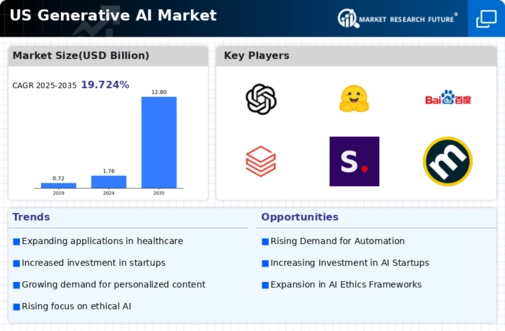Technological Advancements in AI
The rapid evolution of artificial intelligence technologies is a primary driver for the generative ai-in-media-and-entertainment market. Innovations in machine learning algorithms and neural networks enable the creation of more sophisticated content, enhancing user engagement. For instance, AI-driven tools can now generate high-quality scripts, music, and visual effects, which were previously labor-intensive processes. The market is projected to grow at a CAGR of approximately 30% over the next five years, indicating a robust demand for AI solutions in content creation. As these technologies become more accessible, smaller studios and independent creators are likely to leverage them, further expanding the market's reach and diversity.
Increased Investment in AI Startups
The influx of venture capital into AI startups is a notable driver for the generative ai-in-media-and-entertainment market. Investors are recognizing the potential of AI technologies to revolutionize content creation and distribution. In 2025, investments in AI-focused media companies have surged, with funding reaching over $5 billion in the first half of the year alone. This financial backing enables startups to innovate and develop cutting-edge solutions that can disrupt traditional media models. As these companies emerge, they are likely to introduce novel applications of generative AI, further stimulating market growth and competition.
Regulatory Support for AI Innovations
Regulatory frameworks that support the development and deployment of AI technologies are crucial for the generative ai-in-media-and-entertainment market. Policymakers are increasingly recognizing the importance of fostering innovation while ensuring ethical standards. In 2025, several states have introduced initiatives aimed at promoting AI research and development, which could lead to a more favorable environment for AI applications in media. This regulatory support may encourage collaboration between tech companies and content creators, facilitating the integration of AI tools into mainstream media production. As regulations evolve, they are likely to shape the landscape of the generative ai-in-media-and-entertainment market.
Emergence of New Distribution Channels
The rise of digital platforms and streaming services is transforming the distribution landscape for the generative ai-in-media-and-entertainment market. These platforms are increasingly adopting AI technologies to enhance content delivery and user experience. For example, AI algorithms are utilized to recommend personalized content, thereby increasing viewer retention and satisfaction. In 2025, it is estimated that over 50% of media consumption occurs through streaming services, highlighting the shift from traditional media. This transition not only provides creators with new avenues for reaching audiences but also encourages the development of AI-generated content tailored for these platforms.
Consumer Demand for Interactive Experiences
There is a growing consumer appetite for interactive and immersive media experiences, which significantly influences the generative ai-in-media-and-entertainment market. Audiences increasingly seek personalized content that adapts to their preferences, driving the need for AI-generated narratives and environments. This trend is evident in the rise of interactive storytelling platforms and video games that utilize AI to create dynamic content. According to recent surveys, nearly 70% of consumers express interest in AI-generated content that tailors to their individual tastes. This shift towards interactivity not only enhances viewer engagement but also presents new revenue opportunities for creators and distributors.

















Leave a Comment